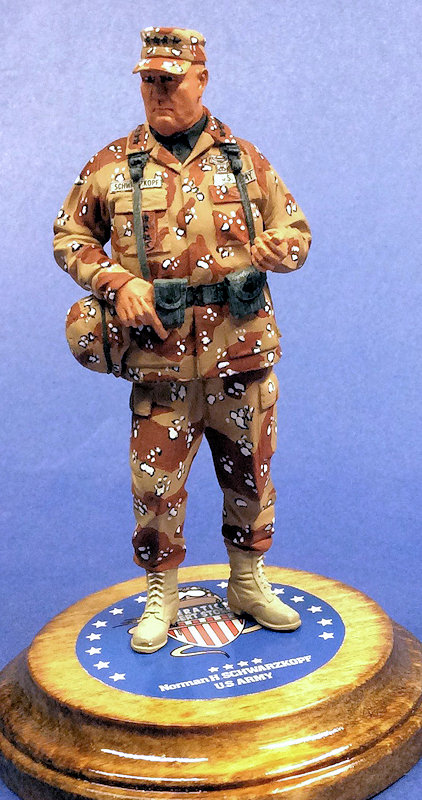 H. Norman
Schwarzkopf, Jr. (AKA “Stormin’ Norman”) was a United States Army general. While
serving as Commander-in-Chief, United States Central Command, he led all
coalition forces in the 1991 Persian Gulf War.
H. Norman
Schwarzkopf, Jr. (AKA “Stormin’ Norman”) was a United States Army general. While
serving as Commander-in-Chief, United States Central Command, he led all
coalition forces in the 1991 Persian Gulf War.| KIT #: | 572 |
| PRICE: | $29.99 SRP |
| DECALS: | Stickers for uniform and base |
| REVIEWER: | Blair Stewart |
| NOTES: | Resin |
| HISTORY |
 H. Norman
Schwarzkopf, Jr. (AKA “Stormin’ Norman”) was a United States Army general. While
serving as Commander-in-Chief, United States Central Command, he led all
coalition forces in the 1991 Persian Gulf War.
H. Norman
Schwarzkopf, Jr. (AKA “Stormin’ Norman”) was a United States Army general. While
serving as Commander-in-Chief, United States Central Command, he led all
coalition forces in the 1991 Persian Gulf War.
Schwarzkopf’s father was a German-American 1917 graduate of the United States Military Academy (West Point) and veteran of World War I. His mother was distantly related to Thomas Jefferson. The senior Schwarzkopf later became the Superintendent of the New Jersey State Police, where he worked as a lead investigator on the 1932 Lindbergh baby kidnapping case.
Born in Trenton, New Jersey, Schwarzkopf, Jr. grew up in the United States and later in Iran. Childhood friends described him as active and assertive, protective of his sisters and a skilled athlete. He spent his childhood attached to his father, who subsequently became the narrator for the Gang Busters radio program. When Norman Schwarzkopf was eight years old, his father returned to the military in World War II. As a 10-year-old cadet at Bordentown Military Institute, near Trenton, he posed for his official photograph wearing a stern expression because – as he said afterwards – "Some day when I become a general, I want people to know that I’m serious." In 1946, when Norman Schwarzkopf was 12, he moved with his father to Tehran, Iran. In Iran, Norman learned shooting, horseback riding, and hunting. Schwarzkopf developed a lifelong interest in Middle Eastern culture. The family moved to Geneva, Switzerland, in 1947, following a new military assignment for Herbert Schwarzkopf. The senior Schwarzkopf visited Italy, Heidelberg, Frankfurt, and Berlin, Germany during his military duties, and the Schwarzkopf, Jr. accompanied him. By 1951 he had returned to Iran briefly before returning to the United States. Herbert Schwarzkopf died in 1958. From a young age, Norman wanted to be a military officer, following his father's example.
Following his dreams, Norman Schwarzkopf, Jr. received an appointment to West Point and his commission as a second lieutenant in the United States Army’s Infantry upon his graduation in 1956. He spent October 1956 to March 1957 at United States Army Infantry School at Fort Benning, Georgia, where he earned his Parachutist Badge. His first assignment was as platoon leader, later executive officer, of E Company, 2nd Airborne Battle Group, 187th Airborne Infantry Regiment, 101st Airborne Division at Fort Campbell, Kentucky. He was promoted to first lieutenant in 1958. In July 1959, Schwarzkopf was assigned his first overseas assignment; as a staff officer alternating with duties as a platoon leader, liaison officer, and reconnaissance platoon leader with the 6th Infantry Division in West Germany. In July 1960, Schwarzkopf was assigned as aide-de-camp to Brigadier General Charles Johnson, who commanded the Berlin Brigade in West Berlin.
Upon his promotion to Captain in July 1961, Schwarzkopf was reassigned to the Advanced Infantry School at Fort Benning, GA. He also earned his Master Parachutist Badge in that time. After completing his Master of Science degree at the University of Southern California, Schwarzkopf returned to West Point to serve as an instructor in the Department of Mechanics. He was originally intended to teach at the Military Academy for three years, but after his first year he volunteered for service in South Vietnam because he thought that career advancement could be most quickly earned in combat. West Point approved his request in early 1965 with the stipulation that he return and teach the remaining two years after his tour.
In Vietnam, Schwarzkopf first served
as an adviser to the South Vietnamese Army and later as a battalion commander.
He served as a task force adviser to the Army of the Republic of Vietnam
Airborne Division. He was promoted to major shortly after he arrived in Vietnam.
After an initial orientation at Military Assistance Command, Vietnam (MACV),
Schwarzkopf was sent north to Pleiku in the central highlands, in the II Corps
Tactical Zone. He got his first combat experience on
August 3, when he was the senior adviser to a force of 1,000 South Vietnamese
paratroopers sent to relieve a beleaguered South Vietnamese Army force at Duc Co
Camp. The paratroopers took heavy casualties and a second, larger force had to
relieve them. Schwarzkopf and his group fought continuously for several days. At
one point, he braved heavy Nor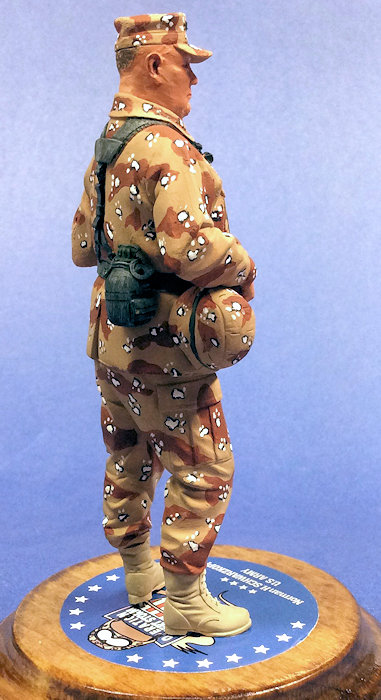 th
Vietnamese fire to recover and treat a handful of wounded South Vietnamese
soldiers and escort them to safety. By August 17 the 173rd Airborne Brigade
arrived and broke the siege, ending the Battle of Duc Co. General William
Westmoreland later arrived to review the incident and congratulate Schwarzkopf.
For his leadership in the battle, Schwarzkopf was awarded the Silver Star.
On February 14, 1966, Schwarzkopf led an ARVN paratrooper assault
on a Viet Cong position, during which he was wounded four times by small arms
fire. In spite of this, he refused medical evacuation or to relinquish command
until the objective had been captured. For this, he was awarded a second Silver
Star and a Purple Heart. He was highly decorated in Vietnam, being awarded three
Silver Star Medals, two Purple Hearts, and the Legion of Merit.
th
Vietnamese fire to recover and treat a handful of wounded South Vietnamese
soldiers and escort them to safety. By August 17 the 173rd Airborne Brigade
arrived and broke the siege, ending the Battle of Duc Co. General William
Westmoreland later arrived to review the incident and congratulate Schwarzkopf.
For his leadership in the battle, Schwarzkopf was awarded the Silver Star.
On February 14, 1966, Schwarzkopf led an ARVN paratrooper assault
on a Viet Cong position, during which he was wounded four times by small arms
fire. In spite of this, he refused medical evacuation or to relinquish command
until the objective had been captured. For this, he was awarded a second Silver
Star and a Purple Heart. He was highly decorated in Vietnam, being awarded three
Silver Star Medals, two Purple Hearts, and the Legion of Merit.
After ten months of combat duty, MACV pulled Schwarzkopf from the front and reassigned him as the senior staff adviser for civil affairs to the ARVN Airborne Division. He then returned to the United States and finished his teaching assignment at West Point, where he was an associate professor in the Department of Mechanics.
In 1969 Schwarzkopf completed the Army's Command and General Staff College course at Fort Leavenworth, Kansas. In this time back home, he also met Brenda Holsinger, a flight attendant for Trans World Airlines. They were introduced at a West Point football game in 1967 and married the next year. The couple would later have three children.
In June 1969, the Army promoted Schwarzkopf to lieutenant colonel and ordered him to a second tour in Vietnam. He was assigned as executive officer to the chief of staff at MACV headquarters, based at Tan Son Nhut Air Base in Saigon. Schwarzkopf later recalled this second tour of duty as being very different from his first: there were 500,000 U.S. troops in Vietnam; the Vietnamization strategy was in effect; and recent events such as the Tet Offensive and My Lai Massacre put troops under increased political scrutiny. In December 1969 he gained his first field command, taking over the 1st Battalion, 6th Infantry, 198th Infantry Brigade at Chu Lai. He later said these troops were initially demoralized and in poor condition, racked with rampant drug use and disciplinary problems as well as a lack of support from home. Despite the brigade's otherwise controversial performance record, Schwarzkopf quickly became known as one of its best combat commanders. He aggressively stepped up patrols and operations to counter Viet Cong infiltration into the battalion's sector. He developed many of his leadership attitudes during this command. Fellow commander Hal Moore later wrote that during his time in Vietnam Schwarzkopf acquired his well-known temper, while arguing via radio for passing American helicopters to land and pick up his wounded men. He also showed a preference of leading from the front and prided himself on avoiding the rear areas, which he called a "cesspool."
During this second tour, Schwarzkopf noted two incidents that haunted him. On February 17, 1970, two men in C Company, 1st Battalion, 6th Infantry were killed by friendly fire from an American artillery shell that had been ordered by Schwarzkopf, but which had struck a tree near their position on its way to a target. The parents of one soldier blamed him for the death of their son, a claim that Schwarzkopf strongly denied and termed an accident of war. On May 28, 1970, Schwarzkopf landed his helicopter when discovering troops of B Company who had stumbled into a minefield. Two company officers had been wounded and two soldiers were trapped, fearful of setting off more mines. Although a medevac was on its way, Schwarzkopf ordered his UH-1 Huey to remove the wounded. As he attempted to help the troops back out of the field, one soldier struck a landmine, breaking a leg, and began to panic. Fearing he would set off another landmine, Schwarzkopf pinned the soldier to the ground while another soldier put a splint on the wounded man's leg. In doing so, another mine was set off, killing three and wounding Schwarzkopf's artillery officer.
Schwarzkopf’s experiences in Vietnam embittered him to U.S. foreign policy. Upon returning to the United States, he remarked of a wariness of future conflicts to author C. D. B. Bryan in 1971. He related these experiences under the assumed name of Lieutenant Colonel Byron Schindler.
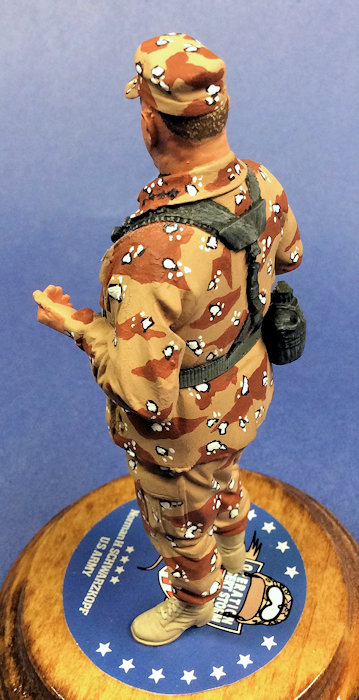 Rising
through the ranks after the war, he later commanded the U.S. 24th Infantry
Division. On October 25, 1983, Schwarzkopf was appointed to the command group
for the Invasion of Grenada. He was the chief army adviser to the overall
operation commander, Vice Admiral Joseph Metcalf III, Commander, United States
Second Fleet/Commander Joint Task Force 120. The operation was plagued by
logistical difficulties, exacerbated by poor communication and lack of
cooperation between the branches of the United States military. Schwarzkopf was
named deputy commander of the invasion at the last minute, leaving him with
little say in the planning. Schwarzkopf helped lead the initial landing
operations while aboard USS Guam. He was involved in an
incident where the colonel commanding the 22nd Marine Amphibious Unit initially
refused to fly Army troops in Marine helicopters. He flew into St. George's on
the second day of the operation. While he initially did not think the U.S.
should have been involved in the conflict, he later said he considered the
mission a success because it re-asserted the dominance of the U.S. military
after the Vietnam War.
Rising
through the ranks after the war, he later commanded the U.S. 24th Infantry
Division. On October 25, 1983, Schwarzkopf was appointed to the command group
for the Invasion of Grenada. He was the chief army adviser to the overall
operation commander, Vice Admiral Joseph Metcalf III, Commander, United States
Second Fleet/Commander Joint Task Force 120. The operation was plagued by
logistical difficulties, exacerbated by poor communication and lack of
cooperation between the branches of the United States military. Schwarzkopf was
named deputy commander of the invasion at the last minute, leaving him with
little say in the planning. Schwarzkopf helped lead the initial landing
operations while aboard USS Guam. He was involved in an
incident where the colonel commanding the 22nd Marine Amphibious Unit initially
refused to fly Army troops in Marine helicopters. He flew into St. George's on
the second day of the operation. While he initially did not think the U.S.
should have been involved in the conflict, he later said he considered the
mission a success because it re-asserted the dominance of the U.S. military
after the Vietnam War.
Following the invasion, Schwarzkopf returned to the 24th Infantry Division and completed his tour as its commander. He was subsequently among those leaders who were criticized for the poor inter-service cooperation in the operation, particularly poor communication between forces of the different branches in combat. The operation was a learning experience for Schwarzkopf, who saw the need to develop greater cooperation between the services for future joint operations. He would later push for more policies to make joint warfare and inter-service cooperation standard practice in warfare. Specifically, the operation demonstrated a need for greater joint roles in planning, deploying troops, and communicating operations. Subsequent operations gave more authority to joint commanders in operations and doctrine emphasized joint warfare doctrine over service-centered doctrine.
In July 1985, Schwarzkopf began an 11-month assignment as Assistant Deputy Chief of Staff for Operations and Plans at the Pentagon. On July 1, 1986, he was promoted to lieutenant general, and was reassigned to Fort Lewis as commander of I Corps. He held this post for 14 months before returning to the Pentagon as Deputy Chief of Staff for Operations and Plans in August 1987. In a second role, Schwarzkopf served as the Army's senior member on the Military Staff Committee at the United Nations Security Council, where he began to build diplomatic skills in dealings with representatives from other countries. As a part of his duties during this posting, he sat in on arms reduction talks with leaders from the Soviet Union.
In November 1988, Schwarzkopf was named commander of United States Central Command (CENTCOM), succeeding General George B. Crist. Schwarzkopf was selected over a more popular choice, Vice Admiral Henry C. "Hank" Mustin, because commanders considered him an accomplished strategic thinker who had experience both in combat and with diplomacy, and who had great knowledge of the Middle East from his childhood experiences there. He assumed command of CENTCOM, with his headquarters at MacDill Air Force Base in Tampa, Florida, and was promoted to general. At the time of this appointment, CENTCOM had overall responsibility for U.S. military operations in 19 countries, and had 200,000 servicemen on call to respond to crises. Schwarzkopf immediately changed the focus of the command, which to that point had focused on the "Zagros Doctrine", a hypothetical ground invasion by the Soviet Union through the Zagros Mountains that the U.S. would counter in Iran. Schwarzkopf was more concerned with the effects of the Iran–Iraq War on the stability of the region than of an external threat posed by the Soviet Union.
In testimony before the Senate Armed Services Committee in March 1989, Schwarzkopf maintained that the Soviet Union was a threat to the region, but when giving an overview of the region’s countries, he noted that Iraq posed a threat to its weaker neighbors. He recommended that the U.S. "seek to assert a moderating influence in Iraq." With regional turmoil growing, Schwarzkopf became concerned about the threat posed by Saddam Hussein, focusing the attention of his command to prepare to respond to what he thought was a "more realistic scenario." That year, his command began planning to counter an Iraqi invasion of Kuwait, seeing it as a likely conflict that would threaten the interests of the United States. In early 1990 he testified again before the Senate Armed Services Committee in threat-assessment hearings that the Cold War was ending and it was less likely the Soviet Union would exert military force in the region. Though he declined to identify Iraq specifically as a threat, he noted a regional conflict was the most likely event to destabilize the region, and noted Iraq's ceasefire with Iran meant it was continuing to enlarge and modernize its military. In early 1990, he drafted a war plan, Operations Plan 1002-90, titled "Defense of the Arabian Peninsula," which envisioned an Iraqi invasion of Saudi Arabia through Kuwait.
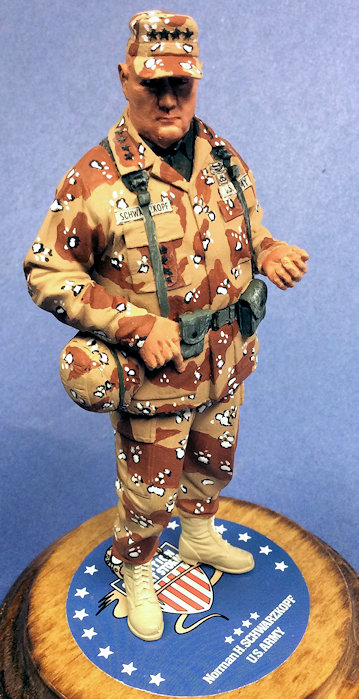 During
CENTCOM military exercises in July 1990, Schwarzkopf wrote up a scenario that
tested how the command would respond to a regional dictator invading a
neighboring country and threatening oil fields there, a scenario that closely
mirrored the rising tension between Iraq and Kuwait. One week after the end of
these exercises, Iraq invaded Kuwait on August 2, 1990.
During
CENTCOM military exercises in July 1990, Schwarzkopf wrote up a scenario that
tested how the command would respond to a regional dictator invading a
neighboring country and threatening oil fields there, a scenario that closely
mirrored the rising tension between Iraq and Kuwait. One week after the end of
these exercises, Iraq invaded Kuwait on August 2, 1990.
Initially believing the Iraqi Army would only advance to the Ramallah oil field, Schwarzkopf was surprised when the Iraqis captured Kuwait City. Fearing Iraq would next invade Saudi Arabia, Schwarzkopf ordered contingency plans put in motion, with the 82nd Airborne Division, 101st Airborne Division and 24th Infantry Division put on alert. He was then called to an emergency meeting with President George H. W. Bush (also a combat veteran), where his Internal Look '90 strategic plans were made the basis of a potential counteroffensive plan. By August 5, Bush opted for an aggressive response to the invasion. Schwarzkopf then accompanied Secretary of Defense Dick Cheney to meet with Saudi King Fahd to convince him to allow U.S. troops into Saudi Arabia to counter the Iraqi military. With Fahd's consent, Bush ordered troops into Saudi Arabia on August 7, initially tasked to defend Saudi Arabia should Iraq attack. U.S. commanders from the beginning wanted a quick conflict characterized by decisive, overwhelming force, as opposed to the gradual escalation of U.S. involvement as had been seen in Vietnam. Schwarzkopf in particular was very adamant that many of the policies governing military operations in Vietnam, especially slow escalation of air power and troop force, not reoccur. His plan for direct and overwhelming force was initially criticized in Washington as uncreative. By August 13, the news media began to closely cover Schwarzkopf, who had been named to lead the operation.
From his headquarters in Tampa, Schwarzkopf began planning the operations to defend Saudi Arabia. Lieutenant General Charles Horner, USAF, ran the headquarters in Riyadh Schwarzkopf planned supply lines for the 50,000 troops initially sent to Saudi Arabia, assigning Major General William G. Pagonis as director of the logistical operations, with U.S. Air Force cargo aircraft landing supplies at Dhahran and U.S. Navy ships offloading troops and supplies at Dammam. By August 20, 20,000 U.S. troops were in Saudi Arabia, with another 80,000 preparing to deploy, and a further 40,000 reserves tapped to augment them. Schwarzkopf arrived at the CENTCOM command in Riyadh on August 25, and on August 29 he conducted his first front-line tour of the potential combat zone, accompanied by reporters. Over the next several weeks, Schwarzkopf spoke frequently with both reporters and troops under his command, conducting many high-profile press conferences and updates to the situation in Saudi Arabia. Schwarzkopf worked to help coordinate the contributions of the different nations contributing military forces to the effort. By mid-October, Schwarzkopf indicated he was confident the forces were of a sufficient level that they could defend Saudi Arabia if it was attacked. Through October, Schwarzkopf and his command were occupied with setting up facilities and supply lines for the troops streaming into Saudi Arabia. He also worked to minimize the culture clash among foreigners in sharia-dominated Saudi Arabia, such as the high visibility of women in military roles. Schwarzkopf remained at his command in Riyadh through December, making frequent frontline visits to the troops. On December 29, 1990, he received a warning order from The Pentagon to be ready to attack into Iraq and Kuwait by January 17.
The air campaign against Iraq began on January 17, 1991, after 139 days of planning and buildup. Schwarzkopf sent a prepared statement to the troops ahead of the first airstrikes, which were timed to hit their targets at 02:40. He oversaw the strikes from his war room in Riyadh, then emerged from his command center late in the day on January 18 to speak to the press, saying the air war had gone "just about exactly as we had intended it to go". He then began making frequent briefings to the media to increase press coverage of the results. He declined to measure the success of the campaign by counting suspected Iraqi casualties, believing this would undermine his credibility. The air campaign proved to be a success by achieving air superiority and destroying the Iraqi military's communications network, supplies, as well as many tanks and armored vehicles. By January 20 he announced Iraq's nuclear test reactors had been destroyed, and by January 27 he announced that the coalition had total air superiority in Iraq. Bush then gave Hussein an ultimatum to withdraw from Kuwait by 12:00 on February 23 or Schwarzkopf's ground forces would attack.
Schwarzkopf began his ground campaign in earnest at 04:00 on February 24, with the Saudi-led Arab forces attacking into Kuwait City, while two U.S. Marine Corps divisions struck at the oil fields, and the VII Corps and XVIII Airborne Corps on the left flank struck quickly to cut off the Iraqi forces from the west, which would later be known as his "Left Hook" strategy (Note: there is lots of evidence to suggest that Schwarzkopf was not the principle architect of this strategy; rather, that title belongs to US Air Force Colonel John Boyd, who is said to be the father of the US Marine Corps’ maneuver warfare doctrine. Two important people who were impressed by Boyd’s theories were Vice President Dick Cheney, then a congressman from Wyoming, and Gen. Alfred Gray, commandant of the Marine Corps from 1987 to 1991.Cheney was secretary of defense during the first Gulf war, and he has credited Boyd's influence as a major reason he changed the battle plan for the liberation of Kuwait from a frontal assault, advocated by Schwarzkopf, which could have led to many American casualties, to the "left hook" that proved so successful).
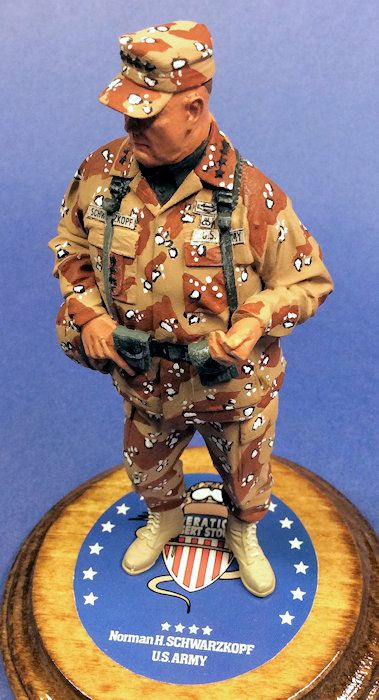 Schwarzkopf
expected the war to last several weeks, and had anticipated chemical weapon
attacks by the Iraqi forces, which did not occur. Resistance was lighter than
Schwarzkopf expected, and Iraqi troops surrendered in large numbers. Within 90
hours, his force had destroyed 42 of 50 Iraqi Army divisions at a cost of about
125 killed and 200 wounded among American troops,[111]
and about 482 killed, 458 wounded among all of the coalition.[112]
He ordered his forces to destroy as much Iraqi armor and equipment as possible
in order to ensure the country's military would be weakened in the long term.
Schwarzkopf, who had ordered a media blackout during the ground
offensive, finally appeared before journalists on February 27 to explain his
strategy. On March 3 he arrived in Kuwait City to survey the aftermath of the
Iraqi occupation and negotiate a ceasefire with Iraqi military leaders, as well
as work out the return of prisoners of war on both sides. With this in place, he
then began the process of overseeing U.S. troops returning from the conflict.
Schwarzkopf
expected the war to last several weeks, and had anticipated chemical weapon
attacks by the Iraqi forces, which did not occur. Resistance was lighter than
Schwarzkopf expected, and Iraqi troops surrendered in large numbers. Within 90
hours, his force had destroyed 42 of 50 Iraqi Army divisions at a cost of about
125 killed and 200 wounded among American troops,[111]
and about 482 killed, 458 wounded among all of the coalition.[112]
He ordered his forces to destroy as much Iraqi armor and equipment as possible
in order to ensure the country's military would be weakened in the long term.
Schwarzkopf, who had ordered a media blackout during the ground
offensive, finally appeared before journalists on February 27 to explain his
strategy. On March 3 he arrived in Kuwait City to survey the aftermath of the
Iraqi occupation and negotiate a ceasefire with Iraqi military leaders, as well
as work out the return of prisoners of war on both sides. With this in place, he
then began the process of overseeing U.S. troops returning from the conflict.
Some questioned why the US led coalition forces did not go all the way to Baghdad and finish the job. In his autobiography “It Doesn’t Take A Hero, Schwartzkopf wrote: “it should be clearly understood that the option of going all the way to Baghdad was never considered,” and “at the time the war ended there was not a single head of state, diplomat, Middle East expert, or military leader who, as far as I am aware, advocated continuing the war and seizing Baghdad.” Finally, he wrote “the United Nations resolutions that provided the legal basis for our military operations in the gulf were clear in their intent: kick the Iraqi military force out of Kuwait. We had authority to take whatever actions were necessary to accomplish that mission, including attacks into Iraq, but we had no authority to invade Iraq for the purpose of capturing the entire country or its capital.”
For his services during the war, he was welcomed back to America with a large parade down Broadway in New York, along with other honors. Schwarzkopf led a highly publicized homecoming parade in Washington, D.C., on June 8, 1991, where President Bush and thousands of onlookers greeted him. His accomplishments were praised in a manner much differently from commanders who returned from the Vietnam and Korean Wars. He became an instant national celebrity and the source of great curiosity by the general public. He was quick to award praise and medals to the troops, part of what he saw as restoring pride in the U.S. armed forces after the Vietnam War.
Schwarzkopf retired shortly after the end of the war and undertook a number of philanthropic ventures, only occasionally stepping into the political spotlight before his death from complications of pneumonia in late 2012.
| THE KIT |
The figure is yet another finely detailed 120mm cast resin military figure by Verlinden. As is typical of these figures, the kit comes in 10 separate cast resin parts with some of them attached to resin casting blocks. The arms, torso and legs are separate components, as are the figure’s saber, riding spurs and hat. As usual, the sculpting of the figure is extremely sharp with the great detail afforded by the large 120mm scale.
Another plus is the “permanent stick” stickers for the figure’s nametags, badges, and a base.
| CONSTRUCTION |
CThe first step was to remove the various pieces from their casting blocks and then clean them up. For the larger pieces, I use a razor saw to cut the piece off the resin block, and then use a sharp Xacto knife to clean things up. Unlike my previous figure, I managed NOT to cut myself with the Xacto knife during construction.
For the torso and legs, their mating surfaces were somewhat uneven once I removed the casting block material, so I used a piece of sandpaper on a flat surface to remove resin and provide a better mating surface for them (also exercise caution here if you use this method: it’s easy to get carried away with the sanding and sand away more material than you want). Once I did this, I used Super Glue to assemble the torso, legs, arms and hands.
| COLORS & MARKINGS |
I prepped the figure with Testors flat white enamel through my Paasche airbrush to serve as the base coat and provide a light base for subsequent hand painting with a combination of acrylics and enamels.
The next step was to hand paint the figure. I began with the head and hands. For these parts I used Testors flat flesh enamel. As always, with figures, a major challenge is the skin tones, and then the proper shading to get some kind of expression on the face. I mixed some Testors flat white with the flesh paint and highlighted raised portions of the figure’s face and hands. I then painted the figure’s hair with acrylic burnt umber.
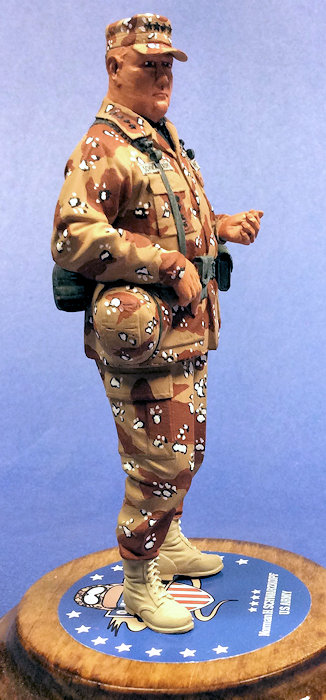 One of the
most difficult things to do on a figure is to paint the eyes. For figures that
are in an action pose, one can generally get by with a “squinting” look that
does not require a painted eyeball. But this figure clearly has open eyes,
although they are somewhat “squinted”. I used Testors flat white to paint in
oblong eyeballs, then some acrylic black to represent the irises. The key to
achieving realistic eyes is to then paint a bottom and top lid over the white
eyeball so that the figure doesn’t have that “bug-eyed” look. For those of you
who are deterred from figure painting by this aspect, trust me: it takes
practice and more practice. It took me three times to get the eyeballs to a
satisfactory state, and I am still not overly thrilled with the result, but it
works for me.
One of the
most difficult things to do on a figure is to paint the eyes. For figures that
are in an action pose, one can generally get by with a “squinting” look that
does not require a painted eyeball. But this figure clearly has open eyes,
although they are somewhat “squinted”. I used Testors flat white to paint in
oblong eyeballs, then some acrylic black to represent the irises. The key to
achieving realistic eyes is to then paint a bottom and top lid over the white
eyeball so that the figure doesn’t have that “bug-eyed” look. For those of you
who are deterred from figure painting by this aspect, trust me: it takes
practice and more practice. It took me three times to get the eyeballs to a
satisfactory state, and I am still not overly thrilled with the result, but it
works for me.
For most of the other parts of the figure, I primarily used relatively inexpensive flat acrylic paints. The desert camouflage uniform was particularly challenging. I used a base coat of Craftsmart Golden Brown. I used Americana Burnt Sienna for the darker brown splotches on the uniform. And now the tough part: the white splotches. These are outlined in black, so it takes quite a while to paint the random white splotches on the uniform, cap and helmet, and then to delicately outline them with flat black. I went back and forth on these by widening the inside white paint and then using the Golden Brown and Burnt Sienna to get to a point where the black outline looked to be about the right width.
For the hot weather, tan-colored desert boots, I used Craftsmart Tan, and then painted the shoelaces with a lighter shade of tan to make them stand out. I painted the ALICE suspender rig and attached equipment pouches with a “custom” shade of olive green made by mixing Craftsmart olive green with black and white. I later dry-brushed a light tan on these items to make them stand out and have that worn OD look. I then painted the hooks and attachments with black acrylic. As a final touch, I used black acrylic to pick out the general’s star insignias on his collars, shirt pocket, and hat.
I like to display my figures on wooden bases purchased from Hobby Lobby or Michaels, and I generally apply some sort of soil or sand base to these. In this case, the included Operation Desert Storm sticker seemed very appropriate for a figure of one of America’s great military commanders. I first stained the base with several coats of Watco Danish Oil. Once this dried, I then rattle canned on several coats of Rustoleum Clear Gloss to give the base that polished wood look. I then centered the Desert Strom sticker on the base’s top. Using a pen vise, I drilled holes in the figure’s boots and the base, inserted some sections of a metal paper clip, and then super-glued the figure to the base.
| CONCLUSIONS |
There you have it. This is another outstanding Verlinden figure, and I am beginning to get obsessed with doing these for two reasons: I can finish them in a relatively short time; and they take up significantly less room when I display them. When completed, the figure presents a great likeness of Stormin’ Norman. If you are into military or other figures, I highly recommend this kit.
| REFERENCES |
Norman Schwarzkopf, Jr. , Wikipedia, February 2016.
General H. Norman Schwarzkopf, “It Doesn’t Take a Hero,” Bantam Books, New York, NY, 1992.
Robert Coram, “Boyd – The Fighter Pilot Who Changed The Art of War,” Little, Brown and Company, New York, NY, 2002.
March 2016
Copyright ModelingMadness.com
If you would like your product reviewed fairly and quickly, please contact the editor or see other details in the Note to Contributors.